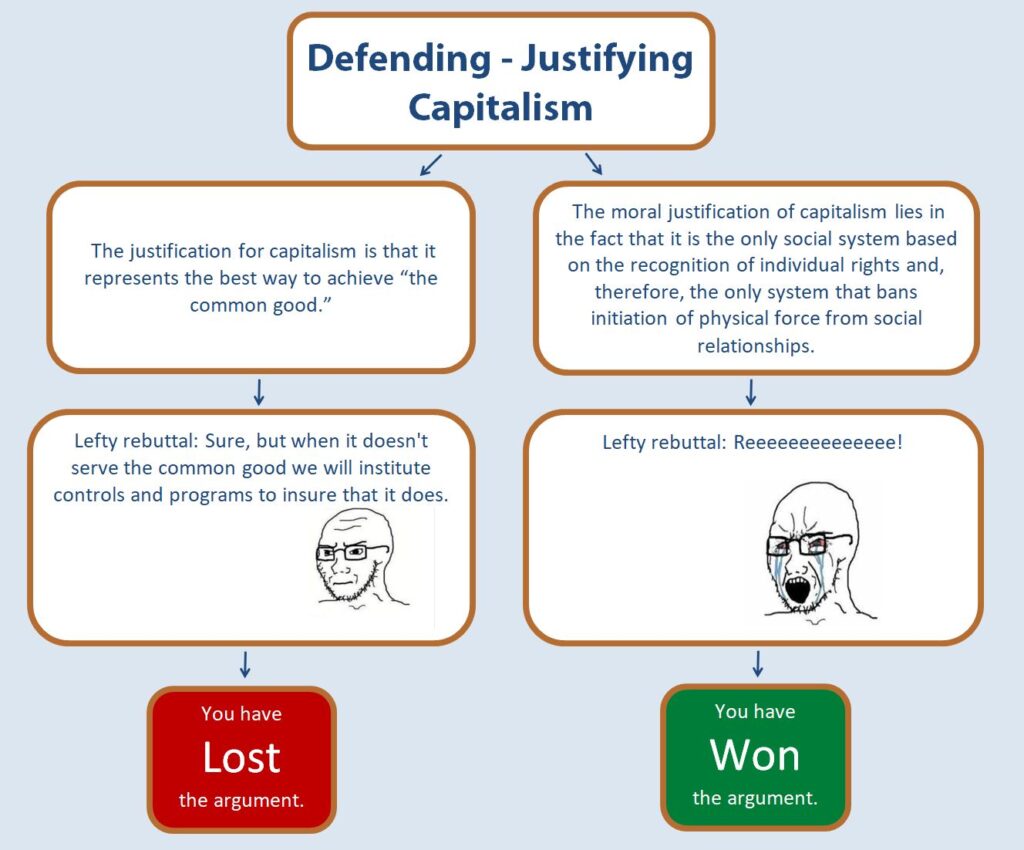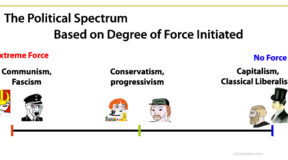This is a new series I am employing and calling it objectivism through flow charts. We are going to take a look at the below flow chart and show how to properly defend capitalism, and how to not defend it. We will discuss why one path leads to winning an argument and why the other path leads to losing. We will also define what winning and losing mean in this context.

The argument portrayed on the left side of the flow chart that capitalism represents the best way to achieve the common good is utilized by many classical liberals and libertarians from Milton Friedman to Jordan Peterson. It is true that capitalism does indeed lead to the common good, so why do we have this as a losing argument? Because once you have accepted the premise that the “common good” is what justifies capitalism the rebuttal is fairly easy. When capitalism is achieving the common good, you can keep it, but when we decide it is not, we will institute controls and regulations, or take it away entirely if necessary. When their own regulations tie capitalism hand and foot from solving the problems, they will declare another failure of capitalism and establish further controls. This, of course, leads to a constant battle of statistics, studies, and economic research, on every single issue, to try to show that it is the government, not capitalism that is causing the problems. If you are a genius charismatic speaker/writer like Milton Friedman, then sure maybe you will easily carry such debates, otherwise good luck.
However, the main problem with this approach is that you allow the left to remain arguing in the realm of logic and reason, while not highlighting the main problem with their ideology.
The argument on the right side of the flow chart solves both of those issues. By justifying capitalism through its recognition of individual rights, you immediately highlight the fact that the left’s ideology is dependent on the violation of rights and the use of initiation of force/coercion to achieve its goals.
I have written the left’s rebuttal to this as “Reeeeeeeeeee, ” because there is no logical or reasoned answer to this. The left does want to use initiation of force to achieve its goals, and when you highlight this to them, it will force them out of the realm of arguments based on reason and logic into emotionalism and evasion. They will try to steal concepts, evade, equivocate, perform logical fallacies, try to change the meaning of words, and eventually, and you will see this, argue against the validity of reason itself. This is why we have marked this as the winning argument. It exposes the fact that the left’s ideology is not based on logic or reason, it disarms them from using reason, and in fact, pushes them to argue against it.
This is a clear win in my book. Winning here is not defined as convincing or converting the largest amount of people. Your audience could be a group of dumb-dumbs that have recanted reason altogether. A win here is viewed as exposing the left as anti-reason, while not appeasing the left by accepting their premises in your own arguments. Of course, I also believe that exposing the left as anti-reason is the most effective way to convince and convert people in the long run, but again that is just the consequence of using a proper defense of capitalism.




